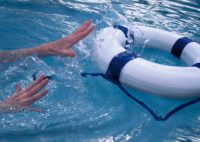Category: Injuries and Illness
Modern safety management goes beyond covering traditional workplace accidents to now being equally concerned with illnesses caused on and even off the job. This section will explain what you need to know to avoid both injuries and illnesses, and to track your progress in reaching this goal.
Free Special REport: Does Your PPE Program Meet OSHA’s Requirements?
Working outdoors in the heat is extra stressful. There’s the stress from whatever work you’re doing, and then there’s the stress on your body created by the need to shed heat. Your workers may know they need to protect themselves. But some of what they’ve heard about preventing heat illness, identifying heat illness, and treating […]
Although drowning is primarily an off-the-job hazard, workers are sometimes at risk on the job as well. Here are some common hazards employers should be aware of in order to prevent drownings. One thing employers may not realize is that workers who are not supposed to be in the water at all could be at […]
In warm weather, increasing numbers of divers suit up to perform underwater operations. Diving has its own set of hazards and safety rules, but employers who utilize divers need to be aware that other hazards may exist besides those inherent in the diving operation itself. That’s what Liquivision Technology found out when the employer contracted […]
Fireworks injuries are on the rise, according to the U.S. Consumer Product Safety Commission (CPSC). In 2013, injuries hit a 10-year high, with eight deaths and an estimated 11,400 consumers who sustained injuries related to fireworks. Most of the injuries were caused by device malfunction and improper use. Warn your workers this Fourth of July […]
Americans will spend more than $2 billion on cookouts this July 4 holiday and will eat more than 150 million hot dogs. And they’ll cook those hot dogs on an assortment of gas, propane, and charcoal grills, which means—if they’re not careful—they could be playing with more fire than they mean to. There are nearly […]
At 5:50 p.m. on May 9, 2015, a transformer exploded at the Indian Point nuclear power plant in Westchester, New York, 50 miles north of Manhattan. Sprinkler systems activated as emergency response crews scrambled, working to keep the fire from the nuclear installation just 200 yards away. The crews poured specially designed fire-fighting foam on […]
Organizations invest large sums into computer equipment—desktops or laptops, monitors, keyboards, mice, and peripherals—and installed software, applications, Web technology, and other telecommunications components. Sometimes, they don’t get the full benefit from those investments, not because of the technology acquired but because of the work environment in which they are used. To maximize the value of […]
According to the Bureau of Labor Statistics, musculoskeletal injuries, also called overexertion injuries, account for approximately 30% of lost-time injuries. Laborers and freight, stock, and material movers experience the highest number of overexertion injuries. These injuries often involve strains and sprains to the lower back, shoulders, and upper limbs. A new publication from the National […]
Slips, trips, and falls on the same level are a leading cause of sprains, strains, tears, and more serious injuries to workers. NIOSH spent 10 years following slip, trip, and fall interventions in three hospitals to determine what caused workers to fall and how falls could best be prevented. Their findings can help all employers […]
Slips, trips, and falls constitute the majority of general industry accidents, according to OSHA—and the vast majority are falls on the same level, not 30-foot falls from a roof or some other height. Falls cause 15% of all accidental deaths, and are second only to motor vehicles as a cause of fatalities. Have you looked […]










